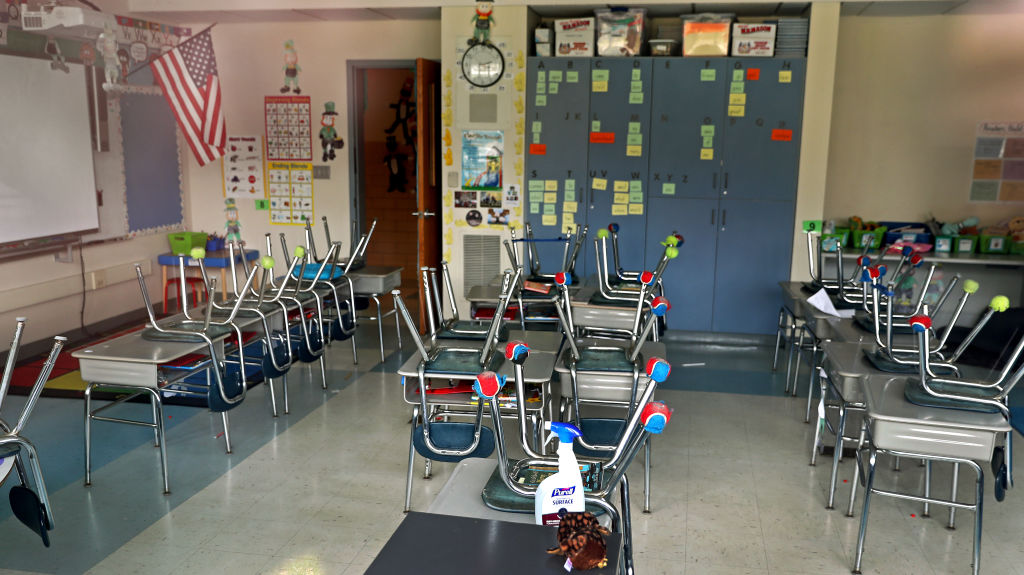Four years ago, on March 12, 2020, Gov. Mike DeWine of Ohio took the extraordinary step of closing all schools in the state in light of the then nascent coronavirus pandemic. In less than a week, the rest of the nation made that extraordinary step ordinary, and America’s public schools would remain closed until the end of the school year.
The school closures and remote schooling that followed are now years behind us. Nonetheless, just as some individuals still suffer from long COVID months after being infected, schools are still suffering from a long COVID of their own.
Having cataloged how the nation’s schools responded to the pandemic for the past four years, I see two main challenges facing schools today. The first is learning loss, which at its height in 2022 saw students more than half a year behind in math and more than a third of a year behind in reading.
The second is less well-known but arguably more important: chronic absenteeism. Typically measured as the percentage of enrolled students who are absent for at least 10 percent of the year, chronic absenteeism includes both excused and unexcused absences, because missing a lot of school for any reason is bad. It’s bad for absent students—with strong links to academic performance, high school completion, and future college-going—and it’s bad for schools, adding to teacher workloads and disrupting routines and learning for consistently attending classmates. Chronic absenteeism may prove the harder problem to fix, as it reflects a cultural shift that stems from habits lost and priorities that changed during the pandemic.
Chronic absenteeism was a major problem before the pandemic, affecting 15 percent of K-12 students, or more than 1 in 7, nationwide. By the second full pandemic school year, chronic absenteeism rates had nearly doubled, reaching 28 percent. We saw large increases across the board, in every state and for all kinds of students. Chronic absenteeism declined 2 percentage points in public schools in 2023, but that still left more than 1 in 4 students missing roughly a month or more of school. That slow rate of decline—if it holds steady—would bring schools back to pre-pandemic levels in 2030, dragging down students and their academic recovery.
While it is obvious that the pandemic caused learning loss and chronic absenteeism, the specific drivers of these changes are murky. Extended closures did affect parents’ enrollment decisions, students’ test scores, and, to a lesser degree, chronic absenteeism rates.
Nonetheless, closures are only part of the story: Districts that were the first to reopen also saw unprecedented lost learning and increased absenteeism, though somewhat less than those with longer closures. To understand the source of these long COVID challenges for schools, we need to take a careful look at how schools responded to the pandemic and pay special attention to how these responses affected students, parents, and teachers’ relationships to school.
The First Pandemic Spring
What we remember about that first pandemic spring is brief total shutdowns that eventually turned into a few months of Zoom school. Such memories, however, are far rosier than what students actually experienced. Data my team at AEI collected in six nationally representative surveys that spring showed that most school districts did not offer Zoom schooling or an equivalent synchronous learning option. Instead, most districts assigned students work through instructional packets, delivered either on paper or through web platforms. Even by June, fewer than half of districts offered live instruction. For most students, that spring was more correspondence school than Zoom school.
Even where live instruction was available, many students did not show up for it. After the Los Angeles Unified School District set up remote-learning programs, as many as 4 in 10 students did not participate. In Clark County, Nevada, teachers had still not made contact with a third of the district’s students—more than 100,000 pupils—by mid-April. Chicago Public Schools reported that 15 percent of students had no contact with their school by May 11. National surveys echoed these big-district struggles: 18 percent of teachers reported being out of contact with at least half of their students throughout the spring, and Education Week surveys found 21 to 25 percent of students were “essentially truant” for remote instruction. At the pandemic’s outset, districts missed about eight instructional days before setting up some kind of remote instruction, but on average more instructional time that spring was lost to students just not showing up.
Little was expected of those who did show up. Students experienced lax attendance requirements and lenient grading policies. Spring 2020’s remote learning was a weak replacement for in-person schooling. That’s understandable, but we can also understand that closures resulted not only in lost learning but also—and perhaps more importantly—lost habits.
Quality schooling depends on habits, rhythms, and expectations—for example, showing up to school every day and putting in effort—that students learn from a young age and that are reinforced on a daily basis by parents, teachers, and the day-to-day routines of school. These habits, rhythms, and expectations fell by the wayside during the pandemic.
The First Full Pandemic School Year
In early summer 2020, it looked as though we might be headed toward a widespread return to school in the fall. But when cases began to rise in mid-summer, then-President Donald Trump tweeted that “SCHOOLS MUST OPEN IN THE FALL!!!” He insisted that school closures were “causing death” and threatened—without the authority to do so—to strip federal funding from schools that didn’t reopen. Unsurprisingly, school reopenings became politically polarized, with the left ardently COVID cautious and the right confidently COVID assertive. Each side became committed to its “common sense” approach to the COVID threat, even as local case numbers surged and waned.
These polarized reopening approaches held throughout much of the year, and political leanings proved more predictive of weekly school closures than local COVID case rates did. At that year’s pandemic record high in December 2020—when vaccines were still not available—fewer than one-fifth of districts Trump won took the precaution of temporary closures, and until mid-March 2021, less than one-fifth of Biden districts were fully open for students.
Politics was not the only in-person learning predictor. Districts with more minority students, urban districts, and historically low-achieving districts were all closed longer than average. Those extended closures, abetted but not solely driven by teachers unions, certainly had negative consequences for eroding the rhythms of schooling, but they were not the only sources of struggle.
Through March 2021, the most common arrangement for districts was part-time in-person instruction. Districts with such an arrangement, as well as districts that were fully open, had to deal with sizable portions of students opting for remote instruction, grapple with social distancing in school, and face rampant quarantines that kept students—and teachers—home unscheduled for weeks at a time. Teachers faced myriad challenges dealing with permanently and temporarily remote students, as well as high rates of absence stemming from the clear public health message: If you are the least bit sick, stay home.
Adulterated schooling that first full pandemic year took a greater toll on students in school districts that stayed remote longer, but it hardly left students in reopened districts unscathed. Optional remote learning, hybrid instruction, quarantines, social distancing, masking, and staffing challenges made schooling that first full pandemic year anything but routine. Fortunately, by year’s end, the period of school closures had passed. Unfortunately, however, the pandemic had not.
The Delta and Omicron School Year
Schools reopened across the board in the second full pandemic school year, a partial vindication of the previous year’s early reopeners, even as the Delta variant surged. Nonetheless, the new school year would see the same political dynamics play out again, with the debate this time hinging on masking policies.
The CDC tightened its masking guidance, issuing a blanket 100-percent masking recommendation that not all districts followed. In Biden districts that September, nearly 8 in 10 students were under a CDC-aligned mask mandate, while in Trump districts just over 4 in 10 were. From then until January, as COVID fell by half and then rose tenfold with the Omicron surge, fewer than 1 in 6 students saw their district’s mask requirements change.
In February 2022, with COVID cases plummeting, several blue states announced the end of their mask mandates, prompting the CDC to replace its blanket guidance with new recommendations based on local COVID case rates and hospitalizations. Over the next six weeks, the percentage of students under mask mandates plummeted from 55 to 5 percent.
In retrospect, school mask mandates might seem inconsequential—how much did masking really affect learning?—but they were hardly trivial. They reflected districts’ urgency –or lack thereof—to get schools back on track, and sent the message to many teachers, parents and students: “Out of an abundance of caution, getting schools back to normal will have to wait.”
And, for most of the second pandemic school year, schools, by their own admission, weren’t back to normal: Nearly 4 in 10 schools reported higher absenteeism among students, and even more reported rises in teacher absenteeism and substitute teachers shortages—not just compared to pre-pandemic, but compared to the first pandemic school year; 8 in 10 schools reported increased student behavior and socioemotional issues; and in 45 percent of schools, “COVID-19 mitigation strategies” posed moderate or large challenges for teachers’ classroom management. These challenges were likely greater in the mostly blue districts with extended mask mandates.
The Post-Pandemic School Years
As substantive pandemic policies in schools ended in the 2022–23 school year, the pandemic’s toll on students and schools started to come into focus.
Spring 2022 tests showed students were more than half a year behind in math and, mercifully, slightly less in reading. Closures took their toll: Lost progress in math was 35 percent larger in the most remote districts compared to the most in-person ones, and the difference in reading scores was even larger. Those are large differences, and are too often downplayed by researchers and policymakers who want to turn the page on pandemic schooling fights and focus on recovery. Still, they are also a relatively modest part of the pandemic toll.
In terms of our nation’s future and lost long-term opportunity for today’s students, learning loss is not insignificant. Economists have pegged students’ lost earnings from learning loss at between $900 billion and $1.3 trillion, and total economic fallout at $31 trillion.
On this front there is some good news: In 2023, students recovered about one-third of their losses in math and about one-quarter in reading in districts with both longer and shorter closures during the first pandemic school year. In other words, that estimated $900 billion in lost earnings should be down by at least a couple hundred billion—not bad for a single school year.
Learning an extra two months of math in a single school year, which is what schools and students did last year, is worth celebrating. But the celebration should be tempered by two cold realities. Such progress would be needed again next year and the year after for students to catch up in math (we would need another year to catch up in reading). Plus, lower-performing students, minority students, and poor students started off with greater losses and are catching up more slowly. Even if schools followed 2023 test score gains with an improbable three- or four-year run, America’s disadvantaged students would still be farther behind the pack than they were in March 2020.
Pandemic learning loss is typically considered the most important post-pandemic challenge for schools. It is not. While academic recovery is crucial, learning loss stemmed from exceptional pandemic policies that are now over. The crisis of chronic absenteeism, however, is an ongoing threat to the future productivity of American schools, one that will hamper continued academic recovery, and learning more generally. Quite simply, if chronic absenteeism rates don’t return to pre-pandemic levels, future students will learn less and graduate at lower rates for some time to come.
Data on chronic absenteeism in public schools, which I have collected from across the nation, show that rates nearly doubled during the pandemic, increasing from 15 percent in 2019 to over 28 percent in 2022. Increases are particularly troubling for the same districts and students that had the greatest learning losses. In 2022, 36 percent of K-12 students were chronically absent in the lowest achieving third of districts, compared to 20 percent in the highest achieving third of districts. Likewise, 36 percent of Hispanic students and 39 percent of black students were chronically absent, compared to 24 percent of white students.
While absenteeism is higher for disadvantaged groups, it’s a mistake to think of it as a problem just for disadvantaged schools. The proportional increase in absenteeism is consistent across different types of students and districts, almost doubling for the poor and non-poor, and for black and white students alike. The duration of school closures during the 2020–21 school year made a significant difference in post-pandemic chronic absenteeism growth, but all schools saw large increases. The major headwinds coming out of the pandemic are hitting all kinds of schools.
Even more concerning is that these absenteeism rates fell only 2 percentage points from 2021-22—the year of the Delta and Omicron surges—to 2022-23, when COVID rates fell dramatically. Chronic absenteeism’s comparably small decline suggests that it isn’t a temporary pandemic phenomenon, but a durable change to post-pandemic student behaviors.
Chronic absenteeism is so troubling because it is a sign that even the most basic rhythms of schooling, such as showing up regularly, have not been restored. Indeed, absenteeism at these rates has already been linked to learning loss, and its stubborn persistence threatens the productivity of American schooling.
Why are we seeing these particular long COVID challenges in schools? The politicized reopening debates and masking fights have dominated our discourse on this matter. However, their link to learning loss and chronic absenteeism is limited. This suggests that learning loss and chronic absenteeism are not simply a matter of lost instructional time or poor pandemic policy but of lower quality schooling and disrupted norms. All schools took a big hit that first COVID spring, and the hits just kept coming over the next two years. Schools didn’t just return to normal when students returned to school. They still haven’t.
After four years of collecting data on the pandemic’s impact on schools, I have come to believe that our long COVID school problems are cultural problems—from within and from without. For years, schooling was not the No. 1 priority, safety was. School closures, lowered expectations, and absences were tolerable if they made us safer. There were strong messages that schools could be dangerous and that schooling could take a back seat to pandemic precautions.
Of course, to some extent that logic was justified—safety is important. But justified or not, pandemic exceptionalism changed behaviors and has been left to linger. Education needs to be prioritized again, not in theory, but in action. Government and school leaders from the president to principals need to say that students need to get back to the work of schooling in earnest.
Changing culture is no small task and will require a concerted and coordinated effort. It will require teachers, who know students best, to use their relationships to communicate the importance of attendance to students and parents. It will require school districts to make students return to consistent attendance—and real consequences for those who don’t. And it will take many parents to change their practices and fulfill their moral and legal obligation to get their students to school regularly.
The alternative is American schools that are weaker, less productive, less connective, and more unequal than they were before the pandemic.






Please note that we at The Dispatch hold ourselves, our work, and our commenters to a higher standard than other places on the internet. We welcome comments that foster genuine debate or discussion—including comments critical of us or our work—but responses that include ad hominem attacks on fellow Dispatch members or are intended to stoke fear and anger may be moderated.
With your membership, you only have the ability to comment on The Morning Dispatch articles. Consider upgrading to join the conversation everywhere.